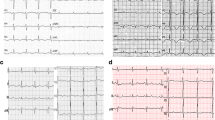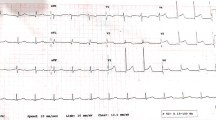Abstract
This case report describes a 31-year-old man with 10 years of cocaine and cannabis dependence who developed reverse Takotsubo cardiomyopathy (rTC), a rare variant of Takotsubo cardiomyopathy. He presented to the Emergency Department (ED) with severe left temporal headache and vomiting which began whilst smoking cannabis and several hours after smoking methamphetamine and using cocaine via insufflation. Computed tomography and angiography of the brain was normal, and the headache resolved with analgesia. Urine drug screen was positive for benzodiazepines, cannabinoids, cocaine, opiates (attributed to morphine administered in ED) and amphetamines. Three hours later he had a seizure and within 10 min developed cardiogenic shock with antero-inferior ST segment depression on electrocardiogram and troponin-T rise to 126 ng/L. Coronary angiography demonstrated normal coronary arteries. Transthoracic echocardiogram demonstrated severely impaired left ventricular (LV) systolic function with ejection fraction 15–20% and hypokinesis sparing the apex. Thyrotoxicosis, nutritional, vasculitic, autoimmune and viral screens were negative. Cardiac magnetic resonance imaging demonstrated severe LV functional impairment with dilated and hypocontractile basal segments, and T2 hyperintensity consistent with myocardial oedema and rTC. He received supportive management. Proposed mechanisms of rTC include catecholamine cardiotoxicity and coronary artery vasospasm. In this case, multiple insults including severe headache, cannabis hyperemesis and cocaine and methamphetamine-induced serotonin toxicity culminated in a drug-induced seizure which led to catecholamine cardiotoxicity resulting in rTC. Clinicians should be cognizant of stress cardiomyopathy as a differential diagnosis in patients with substance use disorders.



Similar content being viewed by others
References
Lyon, A. R., Bossone, E., Schneider, B., Sechtem, U., Citro, R., Underwood, S. R., Sheppard, M. N., Figtree, G. A., Parodi, G., Akashi, Y. J., Ruschitzka, F., Filippatos, G., Mebazaa, A., & Omerovic, E. (2016). Current state of knowledge on Takotsubo syndrome: A Position Statement from the Taskforce on Takotsubo Syndrome of the Heart Failure Association of the European Society of Cardiology. European Journal of Heart Failure, 18(1), 8–27. https://doi.org/10.1002/ejhf.424
Templin, C., Ghadri, J. R., Diekmann, J., Napp, L. C., Bataiosu, D. R., Jaguszewski, M., Cammann, V. L., Sarcon, A., Geyer, V., Neumann, C. A., Seifert, B., Hellermann, J., Schwyzer, M., Eisenhardt, K., Jenewein, J., Franke, J., Katus, H. A., Burgdorf, C., Schunkert, H., … Lüscher, T. F. (2015). Clinical features and outcomes of Takotsubo (stress) cardiomyopathy. New England Journal of Medicine, 373(10), 929–938. https://doi.org/10.1056/nejmoa1406761
Awad, H. H., McNeal, A. R., & Goyal, H. (2018). Reverse Takotsubo cardiomyopathy: A comprehensive review. Annals of Translational Medicine, 6(23), 460–460. https://doi.org/10.21037/atm.2018.11.08
Chehab, O., Ioannou, A., Sawhney, A., Rice, A., & Dubrey, S. (2017). Reverse Takotsubo cardiomyopathy and cardiogenic shock associated with methamphetamine consumption. Journal of Emergency Medicine, 53(5), e81–e83. https://doi.org/10.1016/j.jemermed.2017.06.027
Ramaraj, R., & Movahed, M. R. (2010). Reverse or inverted Takotsubo cardiomyopathy (reverse left ventricular apical ballooning syndrome) presents at a younger age compared with the mid or apical variant and is always associated with triggering stress. Congestive Heart Failure, 16(6), 284–286. https://doi.org/10.1111/j.1751-7133.2010.00188.x
Khoueiry, G., Abi Rafeh, N., Azab, B., Markman, E., Waked, A., Abourjaili, G., Shariff, M., & Costantino, T. (2013). Reverse Takotsubo cardiomyopathy in the setting of anaphylaxis treated with high-dose intravenous epinephrine. Journal of Emergency Medicine, 44(1), 96–99. https://doi.org/10.1016/j.jemermed.2011.09.032
Esnault, P., Née, L., Signouret, T., Jaussaud, N., & Kerbaul, F. (2014). Reverse Takotsubo cardiomyopathy after iatrogenic epinephrine injection requiring percutaneous extracorporeal membrane oxygenation. Canadian Journal of Anesthesia, 61(12), 1093–1097. https://doi.org/10.1007/s12630-014-0230-x
Belliveau, D., & De, S. (2016). Reverse Takotsubo cardiomyopathy following exogenous epinephrine administration in the early postpartum period. Echocardiography, 33(7), 1089–1091. https://doi.org/10.1111/echo.13219
Chou, J., Beutler, L. R., & Goldschlager, N. (2016). Electrocardiography evolution in a woman presenting with alcohol withdrawal seizures and cocaine use. JAMA Internal Medicine, 176(5), 693–695. https://doi.org/10.1001/jamainternmed.2016.0278
Kyi, H. H., Aljariri Alhesan, N., Upadhaya, S., & Al Hadidi, S. (2017). Seizure associated Takotsubo syndrome: A rare combination. Case Reports in Cardiology, 2017, 1–6. https://doi.org/10.1155/2017/8458054
Cotinet, P. A., Bizouarn, P., Roux, F., & Rozec, B. (2021). Management of cardiogenic shock by circulatory support during reverse Tako-Tsubo following amphetamine exposure: A report of two cases. Heart and Lung, 50(3), 465–469. https://doi.org/10.1016/j.hrtlng.2020.10.007
Keituqwa Yanez, I., Nicolas-Franco, S., & Gracia Olivas, J. A. (2017). Heart failure in a case of inverted Takotsubo cardiomyopathy due to cocaine and methamphetamine abuse treated with levosimendan. Archives of Cardiovascular Imaging, 5(1), 1–3. https://doi.org/10.5812/acvi.14401
Meera, S., Vallabhaneni, S., & Shirani, J. (2020). Cannabis-induced basal-mid-left ventricular stress cardiomyopathy: A case report. International Journal of Critical Illness and Injury Science, 10(5), 49–52. https://doi.org/10.4103/IJCIIS.IJCIIS_25_20
Albenque, G., Bohbot, Y., Delpierre, Q., & Tribouilloy, C. (2020). Basal Takotsubo syndrome with transient severe mitral regurgitation caused by drug use: A case report. European Heart Journal—Case Reports, 4(2), 1–6. https://doi.org/10.1093/EHJCR/YTAA028
Fulcher, J., & Wilcox, I. (2013). Basal stress cardiomyopathy induced by exogenous catecholamines in younger adults. International Journal of Cardiology, 168(6), e158–e160. https://doi.org/10.1016/j.ijcard.2013.08.067
Alsidawi, S., Muth, J., & Wilkin, J. (2011). Adderall induced inverted-Takotsubo cardiomyopathy. Catheterization and Cardiovascular Interventions, 78(6), 910–913. https://doi.org/10.1002/ccd.23036
Al-Abri, S., Meier, K. H., Colby, J. M., Smollin, C. G., & Benowitz, N. L. (2014). Cardiogenic shock after use of fluoroamphetamine confirmed with serum and urine levels. Clinical Toxicology, 52(10), 1292–1295. https://doi.org/10.3109/15563650.2014.974262
Movahed, M. R., & Mostafizi, K. (2008). Reverse or inverted left ventricular apical ballooning syndrome (reverse Takotsubo cardiomyopathy) in a young woman in the setting of amphetamine use. Echocardiography, 25(4), 429–432. https://doi.org/10.1111/j.1540-8175.2007.00604.x
Kaoukis, A., Panagopoulou, V., Mojibian, H. R., & Jacoby, D. (2012). Reverse Takotsubo cardiomyopathy associated with the consumption of an energy drink. Circulation, 125, 1584–1585. https://doi.org/10.1161/CIRCULATIONAHA.111.057505
Dai, Z., Fukuda, T., Kinoshita, K., & Komiyama, N. (2020). Inverted Takotsubo cardiomyopathy associated with the consumption of a weight management supplement. CJC Open, 2(1), 26–29. https://doi.org/10.1016/j.cjco.2019.11.002
Rodriguez-Castro, C. E., Saifuddin, F., Porres-Aguilar, M., Said, S., Gough, D., Siddiqui, T., Mukherjee, D., & Abbas, A. (2015). Reverse Takotsubo cardiomyopathy with use of male enhancers. Proceedings (Baylor University Medical Center), 28(1), 78–80. https://doi.org/10.1080/08998280.2015.11929197
Latif, Z., & Garg, N. (2020). The impact of marijuana on the cardiovascular system: A review of the most common cardiovascular events associated with marijuana use. Journal of Clinical Medicine, 9(6), 1–16. https://doi.org/10.3390/jcm9061925
Singh, A., Saluja, S., Kumar, A., Agrawal, S., Thind, M., Nanda, S., & Shirani, J. (2018). Cardiovascular complications of marijuana and related substances: A review. Cardiology and Therapy, 7(1), 45–59. https://doi.org/10.1007/s40119-017-0102-x
Maceira, A. M., Ripoll, C., Cosin-Sales, J., Igual, B., Gavilan, M., Salazar, J., Belloch, V., & Pennell, D. J. (2014). Long term effects of cocaine on the heart assessed by cardiovascular magnetic resonance at 3T. Journal of Cardiovascular Magnetic Resonance, 16(1), 1–12. https://doi.org/10.1186/1532-429X-16-26
Cooper, C. J., Said, S., Alkhateeb, H., Rodriguez, E., Trien, R., Ajmal, S., Blandon, P. A., & Hernandez, G. T. (2013). Dilated cardiomyopathy secondary to chronic cocaine abuse: A case report. BMC Research Notes, 6(536), 1–4. https://doi.org/10.1186/1756-0500-6-536
Zacà, V., Lunghetti, S., Ballo, P., Focardi, M., Favilli, R., & Mondillo, S. (2007). Recovery from cardiomyopathy after abstinence from cocaine. Lancet, 369(9572), 1574. https://doi.org/10.1016/S0140-6736(07)60711-9
Vasica, G., & Tennant, C. C. (2002). Cocaine use and cardiovascular complications. Medical Journal of Australia, 177(5), 260–262. https://doi.org/10.5694/j.1326-5377.2002.tb04761.x
Naranjo, C. A., Busto, U., Sellers, E. M., Sandor, P., Ruiz, I., Roberts, E. A., Janecek, E., Domecq, C., & Greenblatt, D. J. (1981). A method for estimating the probability of adverse drug reactions. Clinical Pharmacology & Therapeutics, 30(2), 239–245.
Paur, H., Wright, P. T., Sikkel, M. B., Tranter, M. H., Mansfield, C., O’Gara, P., Stuckey, D. J., Nikolaev, V. O., Diakonov, I., Pannell, L., Gong, H., Sun, H., Peters, N. S., Petrou, M., Zheng, Z., Gorelik, J., Lyon, A. R., & Harding, S. E. (2012). High levels of circulating epinephrine trigger apical cardiodepression in a β2-adrenergic receptor/Gi-dependent manner: A new model of Takotsubo cardiomyopathy. Circulation, 126(6), 697–706. https://doi.org/10.1161/CIRCULATIONAHA.112.111591
Abe, Y., Tamura, A., & Kadota, J. (2010). Prolonged cardiogenic shock caused by a high-dose intravenous administration of dopamine in a patient with Takotsubo cardiomyopathy. International Journal of Cardiology, 141(1), e1–e3. https://doi.org/10.1016/j.ijcard.2008.11.123
Abraham, J., Mudd, J. O., Kapur, N., Klein, K., Champion, H. C., & Wittstein, I. S. (2009). Stress cardiomyopathy after intravenous administration of catecholamines and beta-receptor agonists. Journal of the American College of Cardiology, 53(15), 1320–1325. https://doi.org/10.1016/j.jacc.2009.02.020
Arias, A. M., Oberti, P. F., Pizarro, R., Falconi, M. L., Pérez De Arenaza, D., Zeffiro, S., & Cagide, A. M. (2011). Dobutamine-precipitated Takotsubo cardiomyopathy mimicking acute myocardial infarction: A multimodality image approach. Circulation, 124, e312–e315. https://doi.org/10.1161/CIRCULATIONAHA.110.008557
Mosley, W. J., Manuchehry, A., McEvoy, C., & Rigolin, V. (2010). Takotsubo cardiomyopathy induced by dobutamine infusion: A new phenomenon or an old disease with a new name. Echocardiography, 27(3), e30–e33. https://doi.org/10.1111/j.1540-8175.2009.01089.x
Funding
This research did not receive any funding.
Author information
Authors and Affiliations
Contributions
EN reviewed the literature and drafted the manuscript. DMR critically revised the manuscript. NJ conceived the idea to report the case and critically revised the manuscript. All authors approved the final version and agree to be accountable for the accuracy and integrity of the work.
Corresponding author
Ethics declarations
Conflict of interest
The authors declare that they have no conflict of interest and do not have any financial disclosures.
Consent for Publication
The patient provided written informed consent for publication.
Additional information
Handling Editor: Y. Robert Li.
Publisher's Note
Springer Nature remains neutral with regard to jurisdictional claims in published maps and institutional affiliations.
Rights and permissions
About this article
Cite this article
Nash, E., Roberts, D.M. & Jamshidi, N. Reverse Takotsubo Cardiomyopathy Precipitated by Chronic Cocaine and Cannabis Use. Cardiovasc Toxicol 21, 1012–1018 (2021). https://doi.org/10.1007/s12012-021-09692-9
Received:
Accepted:
Published:
Issue Date:
DOI: https://doi.org/10.1007/s12012-021-09692-9




